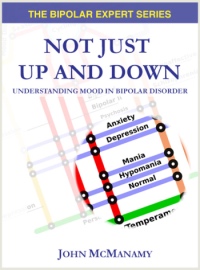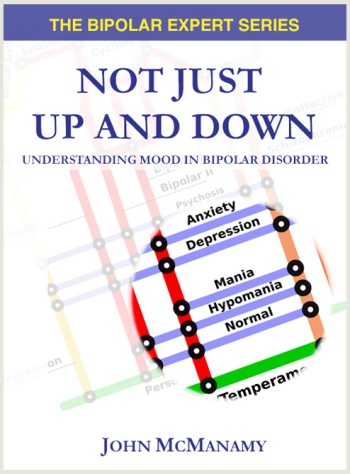The Thought Spectrum - Impaired Thinking
 |
There is way more to a mood disorder than just mood.
|
Impaired thinking in mood. Kay Jamison PhD of Johns Hopkins University in "Touched with Fire" writes:
The illness encompasses the extremes of human experience. Thinking can range from florid psychosis, or madness, to patterns of unusually clear, fast, and creative associations, to retardation so profound that no meaningful activity can occur.
This inability to think clearly is a feature of both depression and mania, as well as psychosis, and its effects are often felt long after an episode has abated, leading experts to question the long-held belief that mood disorders are episodic in favor of the idea that its course may be truly chronic.
My New Book!

Purchase now.
A lengthy review article by Carrie Bearden PhD published in the June 2001 Bipolar Disorders cited "findings of persistent neuropsychological deficits" in long-term bipolar patients, even when tested in symptom-free states. The relationship between these deficits and length of illness led the authors to suggest that "episodes of depression and mania may exact damage to learning and memory systems."
We may share more in common with schizophrenia than we care to admit. Breakthrough research in the field of schizophrenia is shedding new light on our illness, and may lead to treatments that address more than just mood and psychosis.
A Personal Account
In May 2007, I attended the American Psychiatric Annual Association’s annual meeting in San Diego. It was the morning of day three of a six-day conference. I had 30 minutes before pushing off to my first session of the day. I had put in 12 hours the day before, and I was just easing myself into getting off a quick blog in a room reserved for the media. I usually need only a tea to get started in the morning, but for conferences I generally require strategic infusions of Starbucks full strength.
"What did you think of the session we attended yesterday?" asked a journalist a couple of work stations down.
There was an uneasy silence. If this were "Jeopardy!" the music would have stopped playing long ago. I could neither recall where I was yesterday nor the fact that I had been in the same room with this individual.
Then it came back to me in a flash and I fired off a coherent response, but way too late for credibility. "I droop on the Stroop," I managed to say by way of a very pathetic joke.
These days, my internal operating system is far and away the worst aspect of my illness I have to contend with. Moods, shmoods – I actually follow some of the advice in the articles on this site. But when my brain unexpectedly cuts out on me, what am I to do? These are no mere senior moments. The software simply isn’t loading right. When it happens, I know it and the people around me know it. This has been going on for as long as I can remember.
If you don’t think this is any big deal, then ask yourself: Knowing what you now know about me, how safe would you feel with me as an air traffic controller?
What is wrong with my brain?
The 2007 APA annual meeting afforded me the opportunity to search for answers, but first some background …
Cognitive Impairments in Mood Disorders
In a study published in 2004, Deborah Yurgelun-Todd PhD of Harvard and her colleagues scanned the brains of 11 stable bipolar patients while undergoing the Stroop Color-Word Task (more on this in a minute), and found significant delays in their ability to respond with correct answers compared to 10 healthy controls. The study also found decreased activation of the brain region responsible for processing the task compared to the controls.
That same year, I heard Dr Yurgelun-Todd speak at a symposium at the APA annual meeting, where she related how some one-third of the bipolar population are affected by residual cognitive impairments. Accordingly, she argued, cognitive deficits should be regarded as a core feature of bipolar disorder.
We tend to think of bipolar as an episodic mood disorder and schizophrenia as a chronic thought disorder, but clearly the brain studies are pointing to some kind of overlap. The experts seem to be recasting bipolar as a mood disorder with some kind of thought deficit component, but could one take it a step further? Might bipolar, at least in some cases, be regarded as a thought disorder with a mood component?
If there is a mood spectrum, might there also be a thought spectrum? If so, where and how does bipolar fit in?
A Schizophrenia Perspective
My starting point at the APA annual meeting was a three-hour symposium on schizophrenia. If there were such a thing as a thought spectrum, then schizophrenia clearly occupied the severe end. At the symposium, Rona Hu MD of Stanford noted that positive symptoms (namely psychosis) get all the attention in schizophrenia. The DSM makes no specific reference to what experts routinely classify as the "cognitive domain," though three of five symptoms clearly point to what John Nash describes as his brain being "on strike." Nevertheless, the DSM lists schizophrenia under the category, "Schizophrenia and Other Psychotic Disorders."
Yet, Dr Hu pointed out, back in the early twentieth century, none other than the pioneering diagnostician Emil Kraepelin and his disciple Eugen Bleuler observed that "cognitive dysfunction is a core feature of schizophrenia."
Citing a 1999 study by Velligan and Bow-Thomas, Dr Hu noted that cognitive dysfunction affects up to 95 percent of patients with schizophrenia and is responsible for a large proportion of the costs of the illness.
Cognitive deficits refer to executive function, verbal fluency, verbal and visual learning, memory, and attention. The executive function component includes problem solving, forward planning, allocation of attention. motivation, concept formation, self-regulation, and monitoring, and working memory.
Cognitive dysfunction helps explain why only 10 percent of individuals with schizophrenia work full time and 20 percent work part time, with high rates of homelessness, low quality of life, blunted social effectiveness, and difficulty managing their illness effectively.
(Early findings from the NIMH-underwritten STEP-BD ongoing series of treatment trials found that bipolar patients were not exactly functional, either, with only 34.5 percent of the first 1,000 bipolar patients in the study employed full-time, results that roughly correspond with other surveys.)
There are a number of well-established tests for executive function, including:
- The Stroop Color-Word Task – If the word, "Blue," is printed in green, you are expected to call out, "blue," rather than "green." The mind can generally filter out the color-coded distraction, but you need to be on your cognitive game.
- The Wisconsin Card Sorting Test – This involves matching cards according to either color, number, or shape. The individual is not told how to match the cards, only when the match is wrong. Cognitively proficient individuals quickly adapt, even when the rules change.
- The Trail-Making Test – Part B of the Test involves connecting numbers and letters in an alternating pattern (1-A, 2-B, etc).
- The Tower of Hanoi – A more complex form of "The Tower of London," the subject is required to move a set of tiered disks from one peg over a series of pegs back to its original arrangement on a different peg without placing a larger disk on top of a smaller one.
Dr Hu pointed out that the raw results do not necessarily reflect an individual’s true cognitive state. For instance, even Paris Hilton could probably almost get the Wisconsin Card Sorting test right. So testing as respectably adept is small consolation if your first illness outbreak forced you to drop out of Princeton.
But not to worry, that’s what antipsychotics are for, right?
Why Antipsychotics Don’t Do the Job
"Lecture 14." read the item in my APA program book. "Glutamate, the Prefrontal Cortex, and Schizophrenia: Capturing the Angel in Angel Dust."
Hmm. Sounds interesting …
John Krystal MD is a professor of clinical pharmacology at Yale, has published more than 300 papers and chapters on the neurobiology and treatment of schizophrenia, alcoholism, and PTSD, is the recipient of numerous research awards, and is the current editor of "Biological Psychiatry."
"Our medications," he told a packed room, "are least effective for the most disabling symptoms of schizophrenia," namely, "the cognitive dysfunctions that seem to prevent people from performing in the workplace."
Our current treatments, he went on to say, have only tweaked the mechanisms of the older antipsychotics. We have no treatment for schizophrenia that does not depend on the blockade of dopamine D2 receptors. Yet, recent research indicates that limbic dopamine hyperactivity "is only present in some of the patients some of the time." Not only that, some patients have normal and even reduced limbic dopamine activation, and dopamine hyperactivity is limited to only certain circuits in the brain. Not surprisingly, antipsychotics "aren’t that great." You are blocking D2 receptors when you don’t need to be blocking them. Moreover, intermittent dopamine hyperactivity "can’t account for the sustaining features of schizophrenia."
Despite All This, One Abilify Tablet Costs More Than $13.00
This may not be the message that NAMI family members wish to hear. What the pharmaceutical industry never told these long-suffering individuals is that a successful clinical trial for schizophrenia is considered a 30 percent reduction in symptoms as measured on the 30-question PANSS or 16-question BPRS.
A number of symposia at the 2007 APA – industry-sponsored, at that – finally acknowledged the truth, namely that there is no appreciable difference in efficacy between the old-generation and new-generation antipsychotics in treating schizophrenia, and that the metabolic risks involved in the new generation antipsychotics may make patients worse.
The NIMH-underwritten CATIE trials published in 2005 and 2006 served as a wake-up call to psychiatry. But all of this information could be found years before on the labeling of the meds in question, in published studies in leading journals, in treatment guidelines, and in what patients have been telling their doctors since the beginning of time.
Not surprisingly, what should be a moribund antipsychiatry movement was able to muster some 300 people to demonstrate outside that year's APA meeting.
So what about a med that really works? First we need to find a suitable target.
Introducing Glutamate
In his lecture at the APA annual meeting, Dr Krystal explained that glutamate is the dominant excitatory neurotransmitter in the brain, involving 60 percent of the synapses in the cortex. NMDA glutamate receptors are involved in coordinating and adopting glutamate networks, and AMPA/kinate receptors are responsible for excitation. Both these receptors are linked to fast-acting ion channels in the neuron. Metabotropic receptors (mGluR), by contrast, provide a gateway to slower-acting second-messenger systems that regulate neural function.
Glutamate allows one part of the cortex to communicate with another part of the cortex, and the cortex to communicate with the basal ganglia and the midbrain neurons (including ones that release dopamine and other neurotransmitters). By studying the effects of PCP (angel dust) and its derivative ketamine, which block NMDA receptors, Dr Krystal and his colleagues, beginning in the early 1990s, began to reverse-engineer schizophrenia. Ketamine produced both positive and negative (such as flat affect) symptoms of schizophrenia in human subjects, as well as cognitive impairments.
What the ketamine findings showed was that there were many neurobiological paths to psychosis, and not all were dependent on the dopamine D2 receptor. Mice genetically engineered with reduced function in their NMDA receptors showed social deficits somewhat responsive to Clozaril. Mice with knocked out NMDA function in very specific subregions of the brain showed cognitive deficits suggestive of what humans with schizophrenia experience.
New gene studies are revealing that the most commonly implicated genes associated with vulnerability to schizophrenia are genes that affect the development and function of glutamate transmission. These include: neuregulin-1, DISC-1, dystrophin, dysbindin, DAOA, D-serine racemase, plus genes that act on mGluR3, as well as genes that seem to be involved in the convergence of glutamate and dopamine transmission.
Dr Krystal cited postmortem brain and brain scan studies showing a substantial reduction in the dendritic spines of patients with schizophrenia, where "NMDA glutamate receptors do their job coordinating memory function."
A study on monkeys found that those able to remember their tasks sustained their neuronal firing in the prefrontal cortex. In contrast, monkeys who had trouble remembering displayed gaps in their neuronal activity. "In other words, the memory trace was lost in the prefrontal cortex."
The NMDA glutamate receptor and the dopamine D1 receptor are especially involved in this persistent neural activity associated with the maintenance of working memory. Dopamine D2 receptors enter the picture when it is time to shift from maintenance to response. Thus D2 blockers such as antipsychotics "would probably interfere with these sorts of functions."
Ketamine studies on healthy patients indicate that this is where the patients with schizophrenia start to show some deficits.
Perhaps, on a far less severe scale, bipolar producers of websites, as well.
Glutamate Enhancers and Inhibitors
So is there a quick fix? Dr Krystal cited a study which found that high doses of glycine reverses the cognitive impairment of ketamine in healthy subjects, which opens the way for glycine-related treatments. Dopamine D1 receptor agonists are also a possibility. So, believe it or not, is amphetamine, which may impair working memory in a healthy patient but may improve it in someone with schizophrenia (and without the full additive effect on psychosis risk), though please don’t try this at home.
If all that sounds way too simple, Dr Krystal rolled out a far more complicated scenario involving glutamate’s tag team partner, GABA (the main inhibitory neurotransmitter), in particular a group of GABA neurons referred to as chandelier cells. In this context, GABA helps prevent glutamate from running wild. When involved in working memory, GABA tunes out distractions from competing neurons, allowing the brain to focus. But a deficit in NMDA glutamate receptor function effectively disables GABA chandelier cells.
Then a situation develops of "noise amplifying abnormality," resulting in chaos in the prefrontal cortex.
Throw in GABA’s critical role in the smooth oscillation of neural networks, and we are talking about the counter-intuitive strategy of reducing glutamate. Lo and behold, Lamictal reduces glutamate release. Not only that, there have been some findings that this med may enhance the efficacy of Clozaril. Meanwhile, Eli Lilly has in development a drug, LY2140023, which targets the mGluR2 receptor. Stimulating this receptor turns off glutamate release in several brain circuits. In healthy subjects pre-treated with ketamine, the LY drug reduced the disruption in working memory.
In addition, a large phase II Lilly clinical trial found the LY drug worked almost as well as Zyprexa in preventing psychosis.
In case you’re not confused enough: A drug aimed at mGluR2 cleared up impairments related to mechanical difficulties over at the NMDA receptor. Someone needs to be paying these brain scientists a lot more money.
Hope or False Hope?
At the same time, we are entitled to be as skeptical (and hopefully less gullible) as Charlie Brown at the sight of Lucy and her metaphoric football. It is now out in the open that the drug industry, with too much acquiescence from the psychiatric profession, infamously oversold us on second-generation antipsychotics.
What’s different this time is the possibility of a medication that is not yet another variation to 60-year-old Thorazine. Predictably, based on past performance, one can expect the drug industry to market this point to death. The true test will be when confused and zombied-out patients smoking cigarettes in front of TVs in day rooms across the world – even just a small percentage of them - suddenly come to life and find jobs and housing and get into loving relationships.
Believe me, if a med turns out to work that well, there will be no compliance issues. We bipolars will be demanding an FDA indication for us, as well.
Final Words
In any discussion about the DSM, one is likely to encounter the phrase, "carving nature at its joints." The man who coined the term, manic-depression, Emil Kraepelin, refused to wield the cleaver when it came to separating recurrent depression from bipolar disorder (the DSM rolled out the butcher knives for that), but he did make a clear break between manic-depression and schizophrenia. Nevertheless, way back in the early twentieth century - and way ahead of his time - Kraepelin observed a significant thought component to what he called manic-depression. Indeed, Kraepelin made careful observations on thoughts cycling - not unlike moods - from states of stupor to hyper-arousal.
The most vocal champion of Kraepelin is Hagop Akiskal MD of the University of California, San Diego. At an APA symposium entitled, "Lumping Versus Splitting in Psychiatric Nosology," Dr Akiskal pointed out that just before he died, Kraepelin questioned his own manic-depression/schizophrenia dichotomy. "Our patients are violating our own nosology every day," Dr Akiskal observed.
Meanwhile, at another symposium titled, "Deconstructing Psychosis: Research Planning for DSM-V," schizophrenia expert Carol Tamminga MD of the University of Texas, Dallas, noted that:
People who study schizophrenia in my institution are on the sixth floor, people who study bipolar disease are on the seventh floor, and there’s no stairway between, just an elevator. People who study psychotic depression are totally in another building. So there’s very little cross-talk …
See? I do remember what went on at that session. I do, I do. Anyway, let the cross-talk begin.
Go to The Thought Spectrum and Stress for how stress creates special challenges in our ability to think things through.
See also The Thought Spectrum - Thinking Up a Storm for how fatigue and other factors sabotage our ability to concentrate.
Feb 10, 2008, latest update Jan 4, 2011
 |
More articles on mood. |




